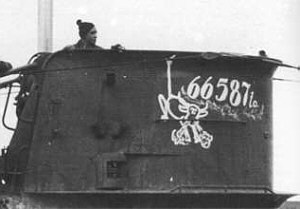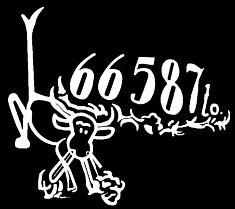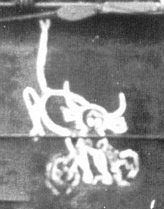U-47 Insignia
Variants of the 'Snorting Bull' insignia during the Spring and Summer of 1940
Return to port after the successful sixth patrol
After the end of its fifth patrol, U-47 was in refit between the 29 April and 31 May 1940. The boat was dry-docked during this refit between 9 and 15 May. Due to the length of time in refit, it is quite probable that the boat and bulls were repainted during this period.
A number of photos were taken of U-47 on 6 July 1940. The boat returned on that day to Kiel at the end of the very successful 6th patrol. On either side of the heavily-weathered conning tower, the tonnage figure of "66587to." appeared in fresh white paint next to the bulls. This figure was obviously applied to celebrate the particularly high tonnage sunk during the patrol.


Left: The bull and 66587to. markings on the starboard side of the tower. The leaves which appear under the numbers were better depicted on the port side than this side of the tower. Note that the tail was still vertical at this stage. Right: A schematic of the "66587to." marking.
The addition of celebratory tonnage figures was reasonably common on U-boats. However, it was more common for the total tonnage a boat had sunk up until that point to appear on U-boat towers. For example, the highest scoring boat U 48 had 157000t, 308000t and 401623Brt painted in white at three stages of her career. Other examples include U-37 (265119t), U-96 (247543BRT), U-101 (190572t) and U-123 (224865t and 304975t).
These figures were notably higher than the tonnage that the boats actually sank. The overestimating of tonnage values was very common indeed, and U-boat commanders generally overestimated by around a third. Although Prien estimated that U-47 had sunk 10 ships of 66,587 tons during patrol its sixth patrol, the actual tonnage sunk was eight ships for 51,189 tons.
If we look closely at the insignia and tonnage figures, we can see that the bulls appear as fresh as the new 66587to. figure. When the 66587to. was applied towards the end of the patrol, the boat was heavily weathered. It follows that the bull would have been similarly faded and weathered at this stage. The bulls, lying directly beside the bright new white tonnage figures, would have looked quite tatty in comparison. It appears that the bulls were retouched at this time with the same white paint used for the tonnage figure.
The snorting bull present during U-47's sixth patrol was different in several respects from the very first bull. Months of continuous U-boat warfare appear to have taken its toll upon the bull, as this version is notably thinner than the original. The bull's face is also much thinner, and slightly shorter in height, than the original. One similarity is the tail, which is still straight on this version, and nearly vertical.
This version of the bull was the same size as the original bull. However, this and subsequent bulls were positioned slightly higher up on the tower. On the original bull, the hooves extended down to the top of the navigation light channel, and the top of the tail was a good distance from the top of the tower bulwark. On this bull (and subsequent bulls), the hooves were located above the top of the navigation light channel, and the top of the tail was close to the top of the tower bulwark.
The Seventh Patrol
After the end of the sixth patrol, U-47 was in refit between the 8 July and 20 August 1940. This was a major refit in which the large L-shaped air trunks were added to the tower. The boat and the bulls were repainted during this refit.
Photos of the boat leaving Kiel at the start of its seventh patrol on 27 August 1940 or arriving at Lorient at the end of the patrol on 26 September 1940 are few and far between. But one photo of the boat at the end of the seventh patrol does allow us to learn of some of the characteristics of this version of the insignia. Firstly, on this version the hoof of the other hind leg is not present underneath the body, as it was on every subsequent version. Another characteristic is the tip of the tail: it splits into two tips just like the earlier bulls. All subsequent bulls would only have one tip at the tail. Lastly, on this version the hooves of the forward legs appear to meet each other.

The bull on a wet and weather-beaten U 47 on the 26th September 1940. The main characteristics of the bull as at the time of U-47's seventh patrol can at least be gleaned from this photo.